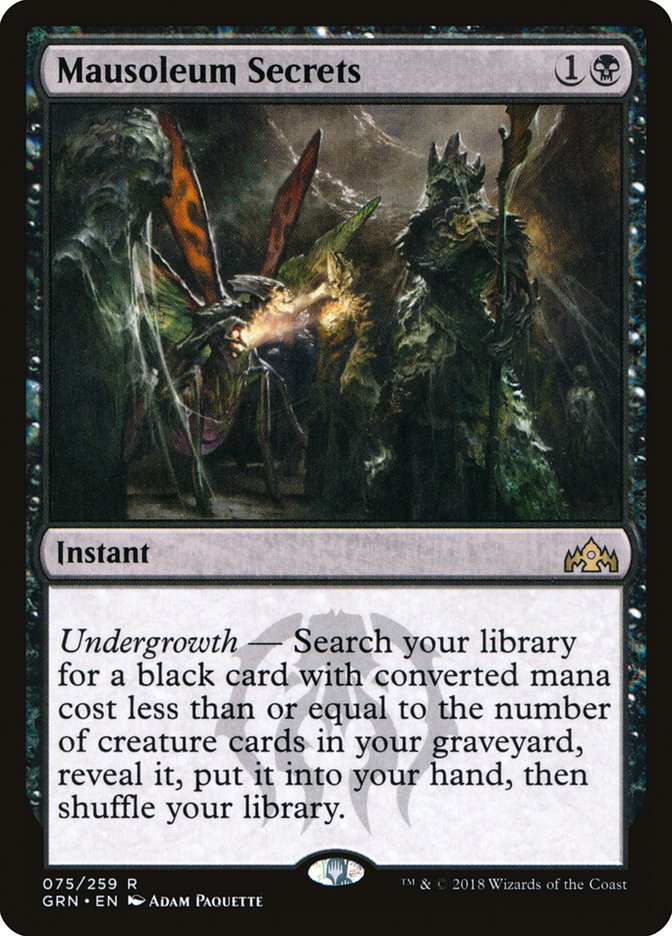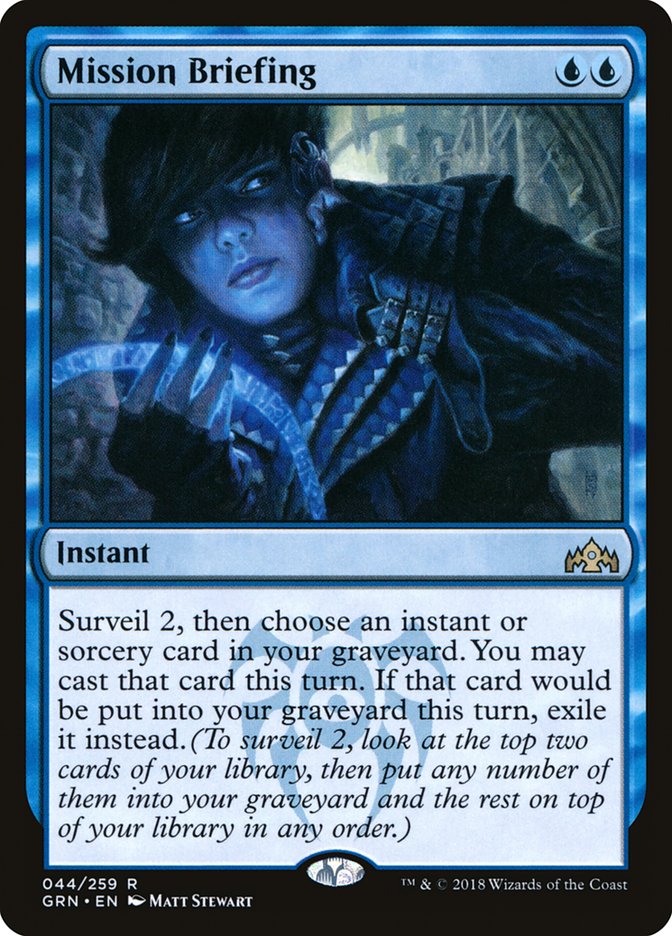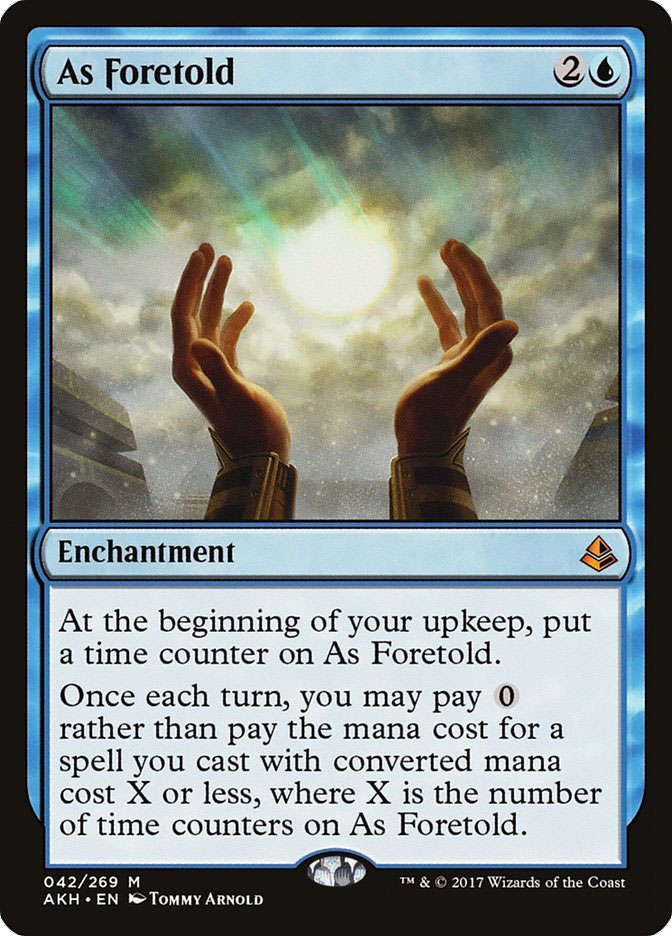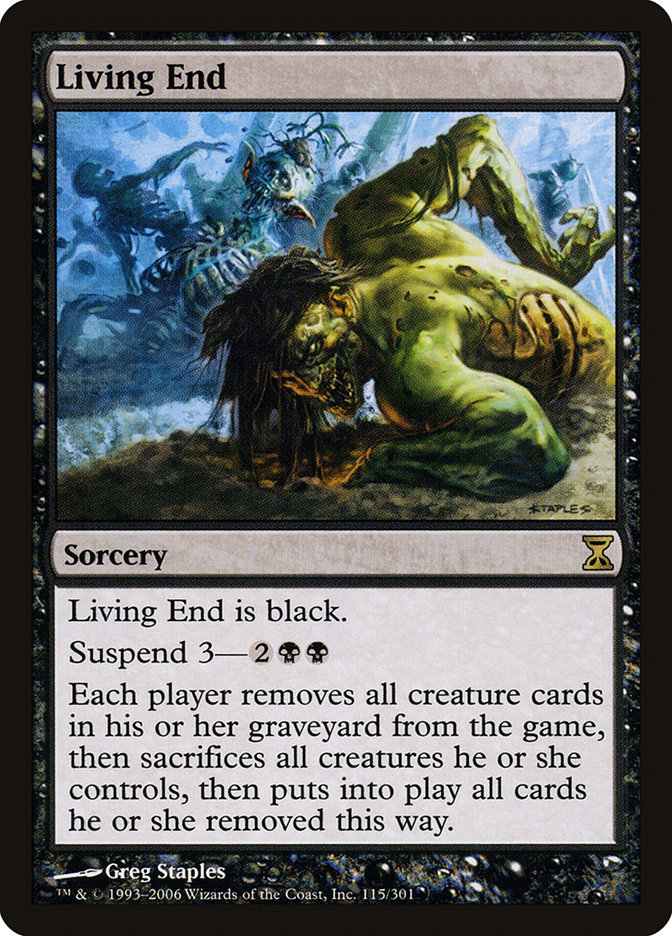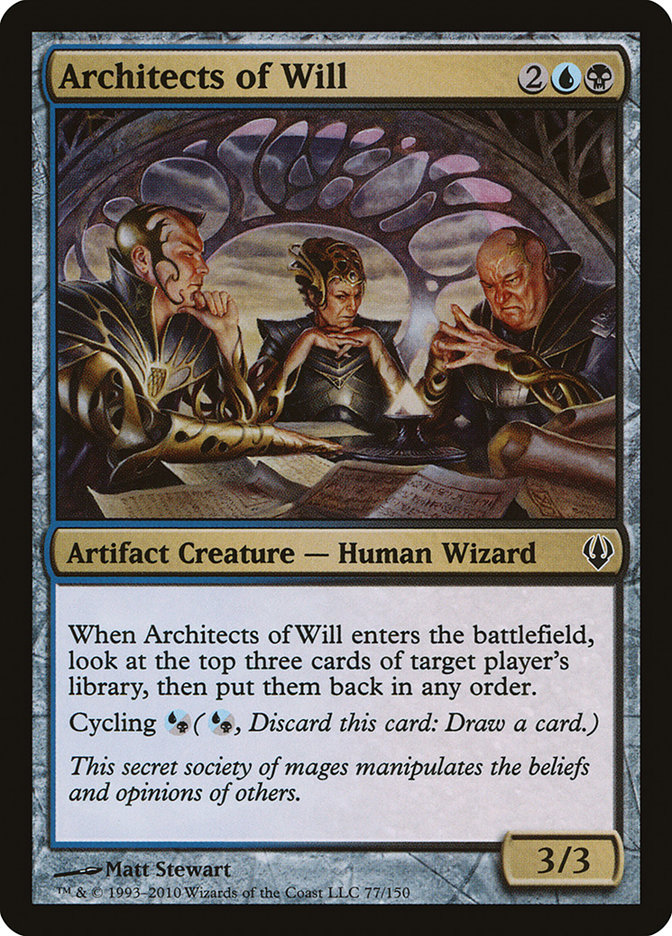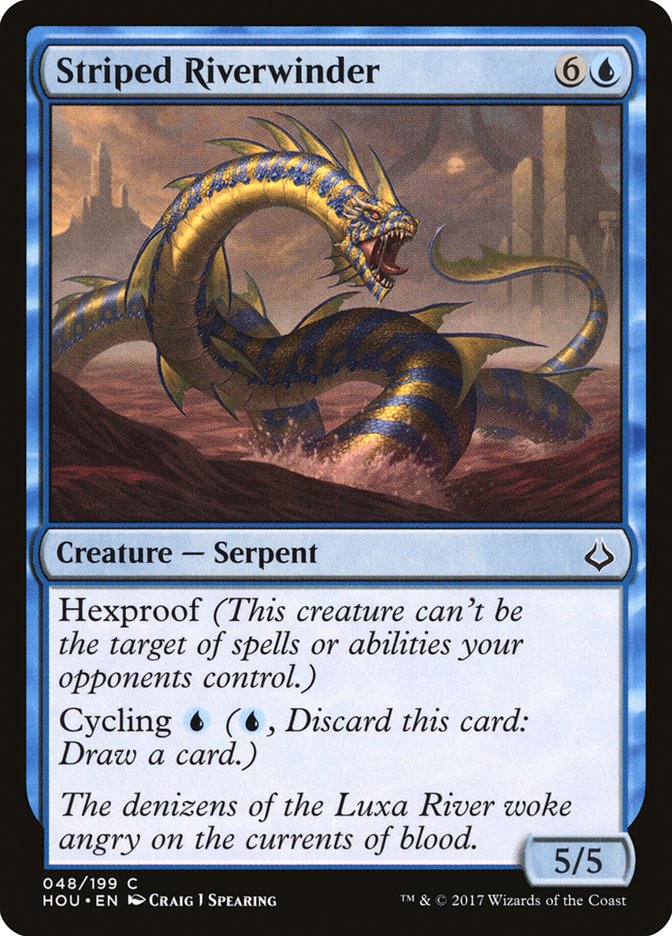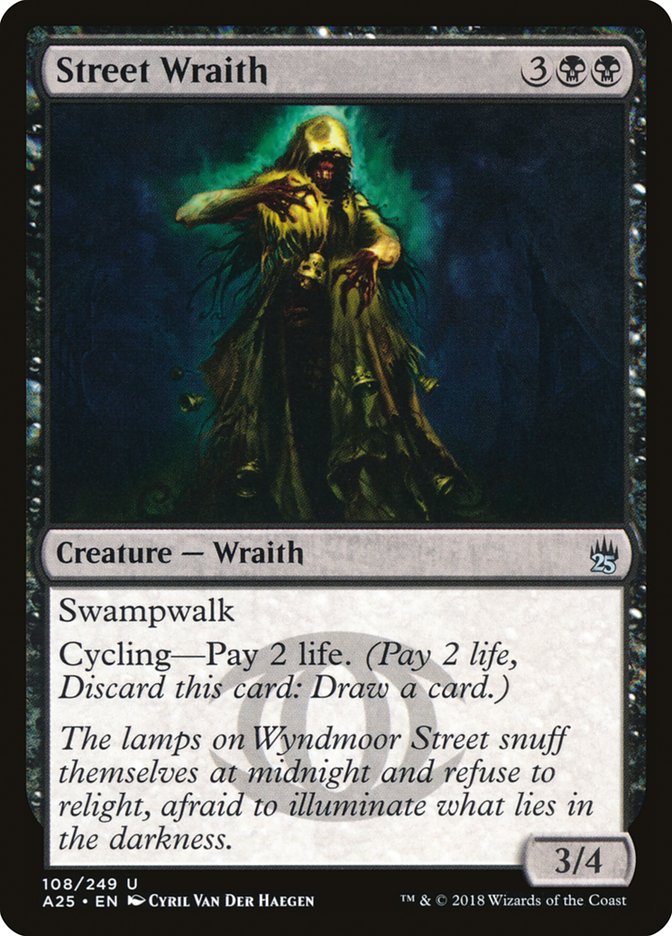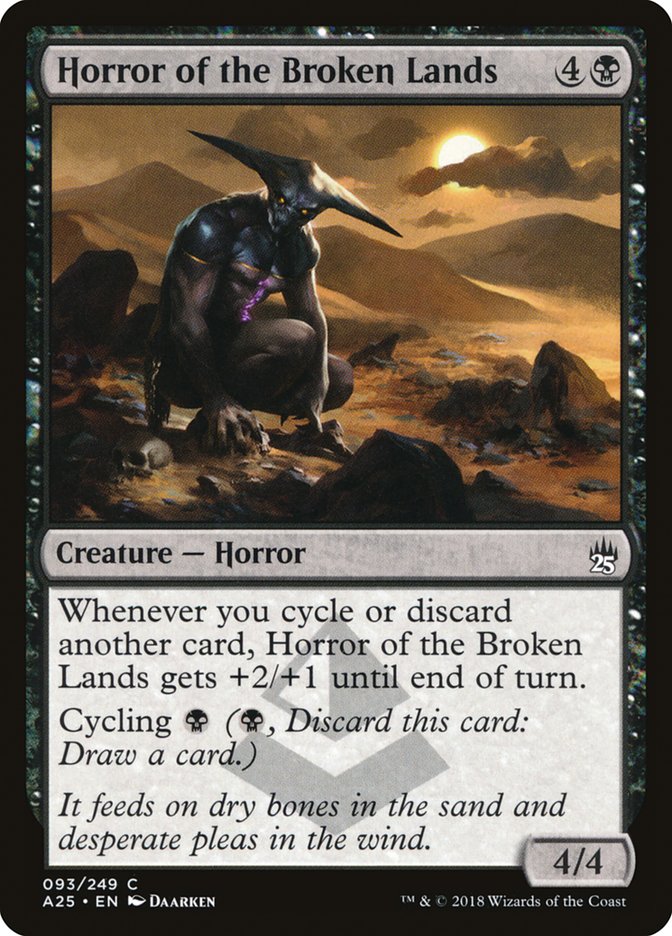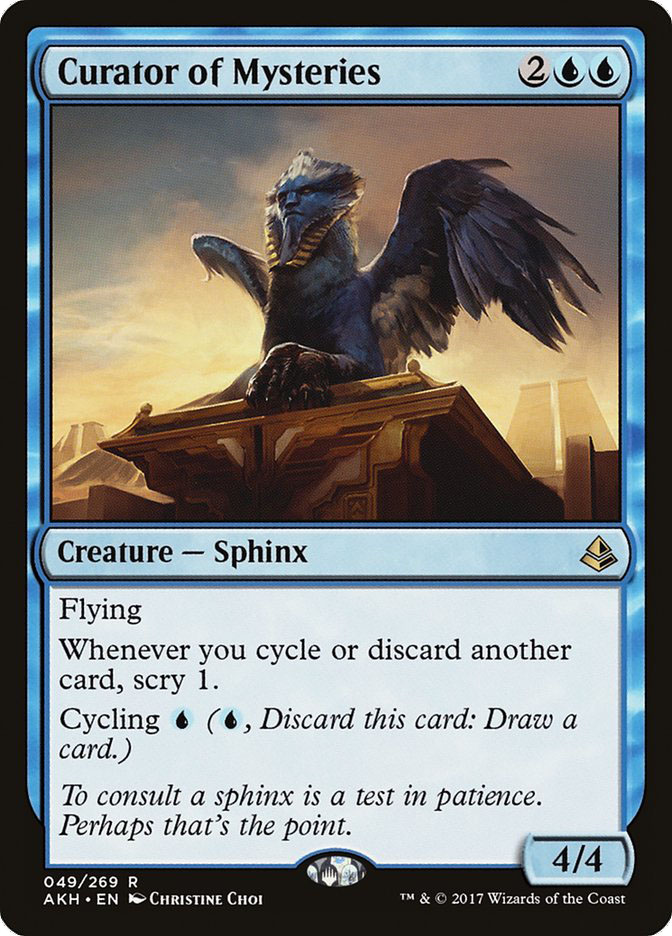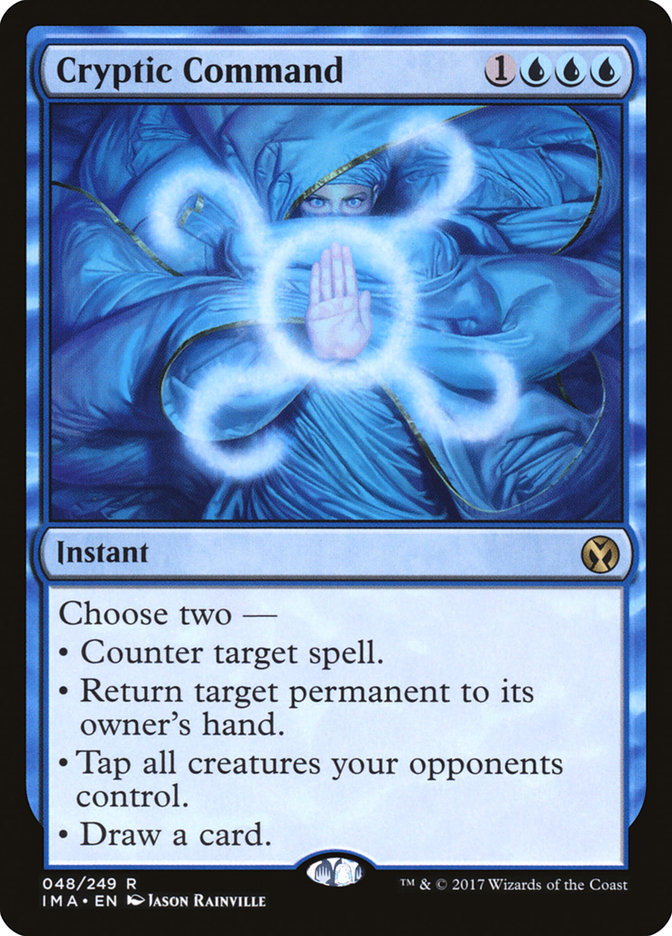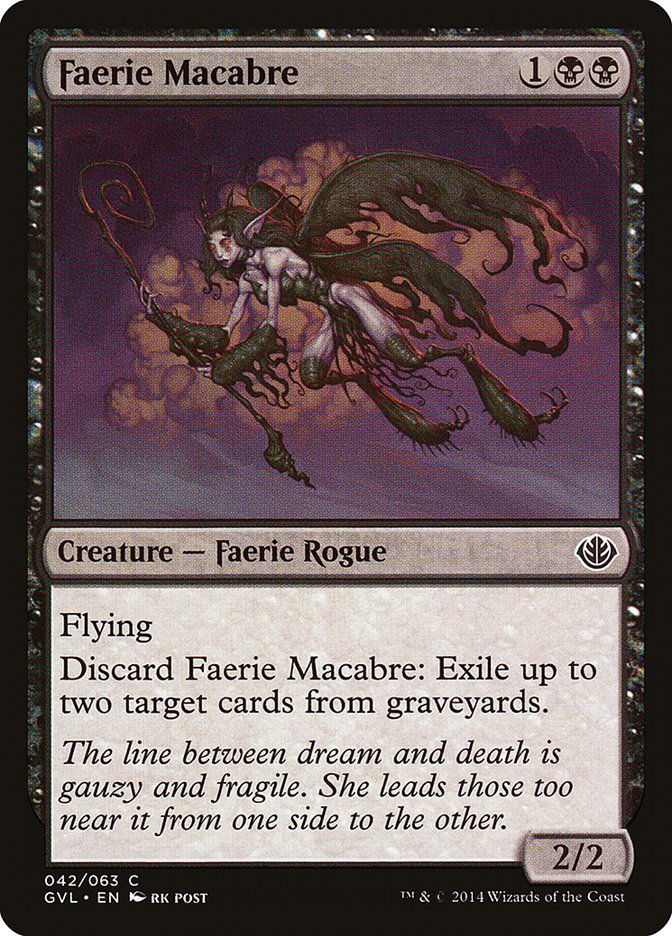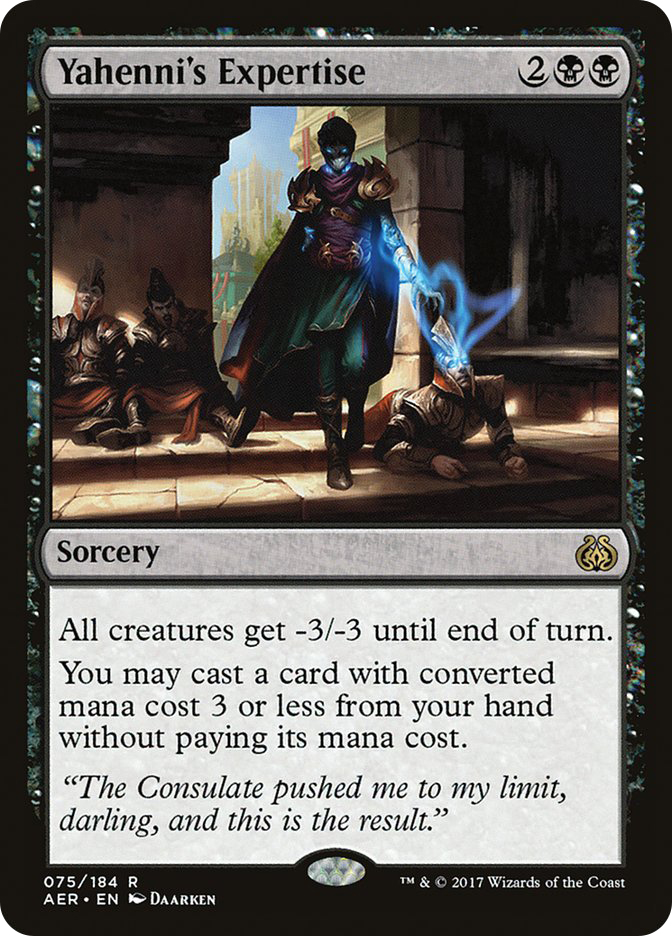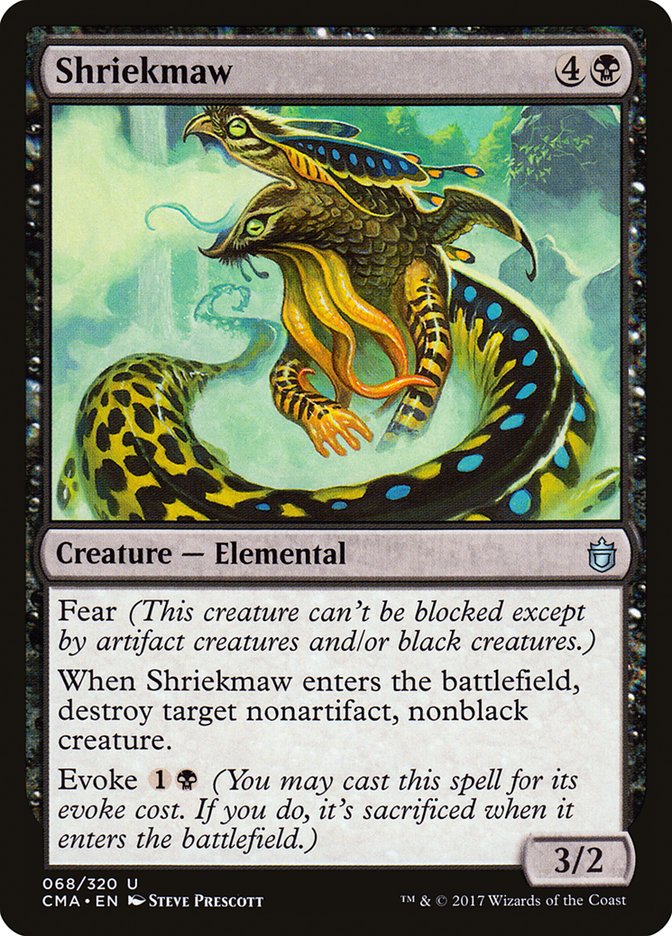When new sets are being previewed, cards with direct historical analogs are
almost always poorly evaluated by a large swath of players. If a new card
reminds us of a card we’ve cast with success before, we’ll almost always
convince ourselves it’s good. In Guilds of Ravnica preview season,
this phenomenon was clearly on display with two rares that generated a lot
of unfounded hype.
The “second coming” of Demonic Tutor and Snapcaster Mage, respectively,
Mausoleum Secrets and Mission Briefing have been near complete busts. There
are a couple reasons why I was able to identify these cards as almost
certain misses in Standard.
Format Card Quality
Anytime you’re evaluating a regrowth or tutor effect, it stands to reason
that the quality of the cards surrounding the effect have incredible
influence over how powerful the effect will be. Recasting an Opt with your
Mission Briefing is very different from recasting a Ponder, Brainstorm, or
Ancestral Recall with your Snapcaster Mage. For this exact reason, we
rarely saw a Dark Petition cast in Standard, but the card was able to play
an important role in Legacy and Vintage combo decks.
If a card is reliant on other cards for its power level, don’t make the
mistake of thinking it’s going to have the same impact that similar effects
with a superior supporting cast have had in the past.
Converted Mana Costs
This can be regarded as a continuation of the previous point, but the
converted mana cost of potential targets for Mission Briefing or Mausoleum
Secrets is generally much higher than the targets for Demonic Tutor or
Snapcaster Mage. How much mana do you have to spend to get a game-changing
impact from a single card? I would argue that in Standard, this power
threshold is crossed somewhere near the four-mana mark. That means you’re
asking for six-mana before you’re starting to get immediate noteworthy
impact out of your tutor or regrowth effect in Standard. This is simply too
much for Constructed playability.
Contrast this with Eternal formats where game-swinging effects are
available for one or even zero mana and you see why these types of cards
are far better suited for Eternal play. Only the very best versions of
these effects make their way into Standard.
Ease of Use Defines the Analog
Demonic Tutor and Snapcaster Mage are only all-time greats because of their
ease of use and acceptable fail states. A 2/1 flash creature for two mana
is completely palatable, and Demonic Tutor has no restrictions on the color
or converted mana cost of the card it finds. These cards can always provide some value no matter what the state of the game may be. You cannot
say the same for Mission Briefing and Mausoleum Secrets. These are cards
with the potential to be absolute blanks. The more cards with dismal fail
states you include in your deck, the more you’re inviting variance to
determine the outcome of your games. In snowball formats like Standard
where executing a consistent gameplan is so important, this amounts to an
unacceptable risk.
All these factors combined made my analysis of Mausoleum Secrets and
Mission Briefing basically identical. I surmised that these cards needed to
do something inherently broken and outside the realm of intended or fair
use, otherwise they would see almost no play. Acknowledging that
“inherently broken” is not something Standard generally deals in, I was
very comfortable not even attempting to build around these cards in Guilds of Ravnica Standard. Time is precious, and we’re in the
business of finding the best deck, not making sure every card has a home.
When it comes to Modern, we’re playing a whole different ballgame. Over the
fifteen years of card creation that Modern draws from, things have often
gotten weird. Sometimes this weirdness puts some incredible card quality
behind what is meant to be a challenging hurdle. Sometimes the weirdness
eschews converted mana costs altogether. Sometimes the weirdness renders
intended drawbacks and difficulty of use irrelevant. When this happens, we
might just end up with something broken.
So, how about something broken?
Creatures (20)
- 4 Street Wraith
- 1 Shriekmaw
- 1 Faerie Macabre
- 3 Architects of Will
- 3 Curator of Mysteries
- 4 Horror of the Broken Lands
- 4 Striped Riverwinder
Lands (19)
Spells (21)
- 4 Remand
- 1 Ancestral Vision
- 4 Living End
- 2 Cryptic Command
- 1 Thoughtseize
- 1 Yahenni's Expertise
- 4 As Foretold
- 4 Mausoleum Secrets
Sideboard

Living End is a deck that I’ve occasionally identified as extremely
well-positioned. I would show up to a tournament with it, be miserable
winning all day, and eventually fall to someone who decided, come hell or
highwater, the 0.87% of the field who brought Living End to the table would
never find a match win against them. This has been the nature of Living End
since it became a Modern deck. It has been entirely devoid of anything even
resembling a “B Plan” and no, your Beast Withins and Fulminator Mages do
not count.
For some folks, this is fine. Indeed, in several contexts, I also love this
approach to Modern. I’ve happily played Mono-Green Tron over the last year
or so and have zero regrets or shame about doing so. But Living End and I
have just never gelled. It felt like the most inconsistent consistent deck
I’d ever played. Imagine my surprise when Mausoleum Secrets turned out to
be the glue I’d been missing all this time. Let’s do the card by card
breakdown thing.
Here’s our core. If you aren’t in on the joke, As Foretold allows us to
cast Living End and Ancestral Vision immediately, with no expenditure of
mana. After the printing of As Foretold, Mono-Blue Living End decks were
briefly the hot new thing, but they ultimately lacked the strategic
flexibility to be long-term players. This deck has no such problems.
Playing less than four copies of As Foretold is almost certainly wrong.
Five cards in our deck are dramatically weakened when we don’t have access
to an As Foretold. Our absolute best draw involves cycling three to five
creatures on the first two turns of the game and playing As Foretold into
Living End on turn 3. For this reason, we’re maxing out on Living End as
well. I flirted with playing only three copies since Mausoleum Secrets
provides additional virtual copies, but I’m a big fan of maximizing access
to your best games and using your mana on turn 2 to cast Mausoleum Secrets
leaves you unable to cycle.
Ancestral Vision is a hard card to evaluate in this deck. It’s undeniably
powerful, but somewhat incongruent with our plans. Ideally, you will never
have to suspend it, and you should almost never suspend it in lieu of
cycling a creature. In sideboard attrition matchups against Jund or Azorius
Control, it becomes a much more important part of your gameplan. Since our
combo is extremely compact, we’re generally not reliant on generating
increased card quantity if our opponent is not actively disrupting us. The
payoff of a suspended Ancestral Vision is a bit too slow for our purposes
and exposing As Foretold to removal when you’re doing anything other than
casting a Living End is too high-risk. For this reason, my copies of
Ancestral Vision are split between the sideboard and maindeck.
In my eyes, the eighteen cyclers represented here are the best available in
the Dimir color combination. I think the balance between Curator of
Mysteries and Architects of Will could be shifted in either direction
depending on matchup expectations. Curator of Mysteries seems like it would
just be the better option, but the ability to manipulate my opponent’s deck
has proven critical in the face of Terminus. We do have slightly fewer
cyclers than the typical build of Living End, but the ones we have are of
higher quality.
Note the absence of Archfiend of Ifnir. I think this card is awful in
Living End. Paying two mana to cycle is unacceptable and I have never once
put counters on my opponent’s creatures with an Archfiend of Ifnir in
either earlier versions of this build or in traditional Living End. This
deck fails to function when it’s unable to cycle a critical mass of its
creatures. Don’t make it harder on yourself than it needs to be by playing
Archfiend of Ifnir.
No longer forced to F6 through our opponent’s turns, we’re going hard on
the counterspells that slow down our opponents while moving us closer to
our combo. Living End is going to live or die on the first three to four
turns of the game, and maxing Remand allows us to participate in those
turns at positive tempo. I experimented with Censor in Remand’s place, but
again, Terminus was a huge factor in my final decision.
I’d love to have four copies of Cryptic Command in this deck, but we do
only play nineteen lands and are hopefully regularly achieving our goals in
the period before Cryptic Command even comes online. Having access to this
card allows us to play out of all kinds of troubling situations, and really
epitomizes the type of flexibility this new version of Living End gets
access to. Cryptic Command is going to bounce hate, win races, protect your
creatures, disrupt your opponent, and draw critical combo pieces. It’s one
of the best cards in Modern, and now it’s finally got a combo-control home
to shine in.
Having talked at length about how Mausoleum Secrets wasn’t up to snuff in
Standard, I feel obligated to explain why things have changed here, even
though it seems patently obvious. First, we’re playing a deck that cares
about access to a specific black card. It helps that Living End has a CMC
of zero, but the reason Mausoleum Secrets can function as a mini-tool box
and transition us to our sideboard plan so effectively is because this deck
will always put creatures into the graveyard. The hoops and restrictions of
undergrowth are effectively erased in a deck with the unique operating
procedure of Living End.
This deck also takes full advantage of the fact that Mausoleum Secrets is
an instant. In spots where you choose to hold up countermagic and your
opponent passes, you can still advance your primary plan of casting Living
End.
I can honestly say that I have cast a Mausoleum Secrets for every single
black card in my maindeck and sideboard except Mausoleum Secrets.
Consistency is key when it comes to combos, and Mausoleum Secrets is
providing it in spades.
The four bullets here should all be obvious in their function. Thoughtseize
to force through key spells, Shriekmaw to kill hate bears, Faerie Macabre
to disrupt a combo or attempt at recursion, etc. etc… Including Yahenni’s
Expertise was a huge breakthrough for the deck, as it gives us the ability
to cast Living End even in the absence of As Foretold while also
functioning as a completely reasonable sweeper.
I knew I was on to something early in testing when an Azorius Control
opponent tapped out for a Jace, the Mind Sculptor and I was able to search
for Yahenni’s Expertise at the end of their turn, use it to cast Living End
and return an Architect of Will (and friends) that removed the Terminus
from the top of their deck. By the time my opponent was able to Brainstorm
again and set up Terminus on my next turn, I now had Remand mana untapped.
While the prospect of a more consistent, versatile Living End deck should
already be enough to pique your interest, this list also comes with a bold
new approach to sideboard games.
The Transformational Sideboard
Earlier I spoke about power level and converted mana costs dictating how
strong a tutor can potentially be. So, I put a bunch of one-mana 12/12s in
my sideboard. Thoughtseize, Street Wraith, shocks and fetches,
counterspells… what’s not to love? Reduced numbers of cyclers and actual
good spells finally allow Living End to transition to a new strategy in
sideboard games and the results have been promising. Rather than talk
sideboard guide, I want to discuss three sideboard postures, identify where
each is strong, and look at your new 60-card deck under each.
The Whole Shebang
Creatures (20)
- 4 Street Wraith
- 2 Shriekmaw
- 4 Faerie Macabre
- 3 Architects of Will
- 4 Death's Shadow
- 3 Curator of Mysteries
Lands (19)
Spells (21)

As you can see, in this configuration we have wholesale abandoned the
Living End plan, cutting our eight most expensive cyclers, Living Ends, and
some Mausoleum Secrets, along with a Yahenni’s Expertise. I’ve employed
plans like this against the combo decks with access to strong graveyard
hate, Mono-Green Tron and Azorius Control. Mausoleum Secrets is great for
finding additional Death’s Shadows, but you must be aware of what type of
graveyard hate your opponent will employ. We’re not going to be in the
business of trying to stop our opponent’s graveyard disruption in this
configuration. In fact, we want them to waste their time mulliganing for
and casting cards that we just don’t care that much about. Given this, we
must limit how many dead cards we’re stuck with if they resolve a Rest in
Peace. When faced with something like Grafdigger’s Cage or Surgical
Extraction, we basically get to laugh it off. If faced with these cards,
make sure you cut a couple As Foretolds and bring back additional Mausoleum
Secrets in game 3s.
The plan is just to make our opponents fight over the wrong things and
focus on pressuring with early Death’s Shadows, Faerie Macabres, and
Curator of Mysteries while disrupting their roads to victory via
Thoughtseizes and Unmoored Egos. None of this will be pretty, but it truly
does work, especially where our opponents are focused on the wrong things.
As Foretold will almost always be your worst card in sideboard games, but
your opponent doesn’t need to know that. And if you do happen to resolve
the card, the mana advantage can be occasionally useful when you are
seeking to advance your board state while leveraging Cryptic Command.
Half Measures
Creatures (19)
- 4 Street Wraith
- 2 Shriekmaw
- 4 Faerie Macabre
- 2 Architects of Will
- 4 Death's Shadow
- 3 Curator of Mysteries
Lands (19)
Spells (22)

This configuration assumes our opponents have some light hate and are
planning on winning through creature combat. I’ve mostly employed this
approach against black-based midrange decks. These sideboard matchups feel
incredibly close, which is unsurprising. The modus operandi of these
black-based midrange decks is opting into a bunch of 50/50s, and this is
another one to add to the list. Here’s where we finally want to suspend
those Ancestral Visions on turn 1. In fact, if you expect a lot of
black-based midrange decks in your metagame, I’d look to find space for a
third copy. It’s the best possible start in the matchup.
The Boop
Creatures (24)
- 4 Street Wraith
- 2 Shriekmaw
- 2 Faerie Macabre
- 3 Architects of Will
- 2 Death's Shadow
- 3 Curator of Mysteries
- 4 Horror of the Broken Lands
- 4 Striped Riverwinder
Lands (19)
Spells (17)
- 2 Ancestral Vision
- 4 Living End
- 2 Cryptic Command
- 1 Yahenni's Expertise
- 4 As Foretold
- 4 Mausoleum Secrets
Sideboard

There are still a lot of decks that don’t pack any significant amount of
graveyard hate. This configuration is how I would sideboard against Humans.
We’re not super excited about the Faerie Macabres and Death’s Shadows we’ve
brought in here, but the “A plan” remains solid and our Mausoleum Secrets
will be able to find the pieces we need to get us out of sticky situations.
The main priority is getting the awful Remands out of our deck. There’s no
need to do anything dramatic. You’re still playing a tight matchup, but
neither side has all that much that can fundamentally change games after
sideboard. We can bear Sin Collectors particularly well and lists typically
only play a single Anafenza, the Foremost.
I love being able to maintain these proactive plans in sideboard games.
Assuming the doubly weak role of sideboarding in reactive cards to
counteract your opponent’s already reactive cards has always struck me as
suboptimal Magic. Despite my inclination, I recognize that conventional
wisdom has embraced these reactive sideboard plans for combo decks for
decades now. If you’re of the mindset that you’d rather work to defeat your
opponents hate and still focus on just resolving a Living End, I think this
version of the deck can accommodate you.
Creatures (19)
- 4 Street Wraith
- 1 Faerie Macabre
- 3 Architects of Will
- 3 Curator of Mysteries
- 4 Horror of the Broken Lands
- 4 Striped Riverwinder
Lands (19)
Spells (22)

The green splash here is pretty clean and the maindeck Assassin’s Trophy
that can be found by Mausoleum Secrets is sure to steal a game or two.
Perhaps Death’s Shadow will prove to be a little too fancy and the correct
version of the deck will end up looking more like this. However, while
Dredge is firmly in the crosshairs of the average player I personally will
be hesitant to take the reactive stance in sideboard games, fearing an
absolute overload of hate. But hey, maybe sharing this version of the deck
forces my opponents to respect the possibility I may not be transforming in
sideboard games. It’s worth a shot!
When I was watching preview season for Guilds of Ravnica unfold, I
never dreamed that Living End would be the deck to find an exciting new
tool. When it comes to Living End, the strategy is so linear that preview
season basically consists of looking for new cyclers. But Mausoleum Secrets
is the truth and might finally push Living End to the top after all these
years.
As far as Mission Briefing goes, I haven’t figured that puzzle out yet. I
think the awkward double-blue casting cost gets in the way of a lot of
potential uses, but it won’t surprise me when this card eventually finds a
very specific home. My hot take? Mission Briefing ends up seeing zero play
in every format… except for in Vintage where it eventually ends up
restricted.
Magic is a crazy game, isn’t it?


